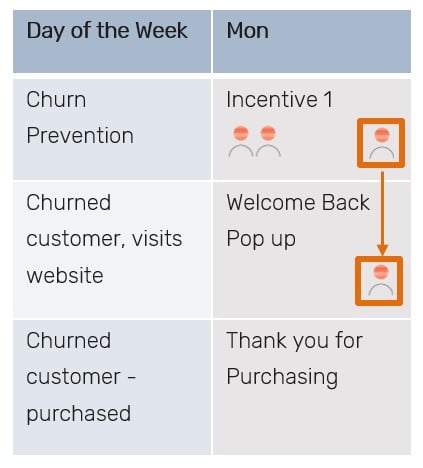
AI and the Retail Marketer’s Future
How AI transforms strategy and processes, driving the adoption of Positionless Marketing
Exclusive Forrester Report on AI in Marketing

Welcome to the second part of this mini-series, where we explain how prioritization and exclusion can be used to create a holistic, personalized customer experience in an effective and efficient manner. In the first part of this series, we described the importance of orchestration, especially as the world adapts to the COVID-19 crisis and its aftermath. We listed four methodologies that marketers can use to orchestrate customer journeys:
While the first and second methodologies don’t require many additional resources, the more advanced approaches do. Implementing techniques for prioritization, exclusion, and A.I. based journeys require you to establish some other capabilities first. In this blog, we will describe some of those foundational capabilities:
Let’s begin. (Or continue.)
For marketers to target customers with specific communications and promotions, they first need to define the audience they would like to send each communication to. To create multidimensional and accurate customer segments, you need direct access to your customer data. As there are many touchpoints, it is crucial to have the ability to consolidate data to a single customer view. Information derived from customer activities, behaviors, and preferences can help you adjust the promotions you offer. This will ensure each customer segment is receiving the most appropriate and beneficial treatment by properly using rules for prioritizations and exclusion. Additionally, and perhaps more importantly – by creating elaborate customer segments, you can define which customers should be excluded from specific communications to deliver the ideal, next-best-action.
Marketers must be able to measure the effectiveness of their efforts, to know what works and what doesn’t. Not only because it will justify the cost of campaigns or help you modify when necessary, but also because it allows you to prioritize the different communications a customer may be eligible for based on each campaign’s impact.
Identifying what communication generated the best outcome enables you to prioritize communications to create lucrative customer journeys.
As marketers typically refrain from sending more than one message to a customer a day and generally have a cap on how many communications you send each week - you need the tools to choose the best campaign. And we can give you some insight on that.
One of the ways to choose the next-best-action is to measure the incremental monetary impact of each. For example, a new customer is eligible for two of the following campaigns:
 Alternatively, you can choose to send the ‘Day 3 of the Welcome Series’ and the ‘Birthday Campaign’ by including customers who received other communications that day.Knowing that the average uplift from a ‘Birthday Campaign’ is $41 higher than the ‘Welcome Series’ campaign highlights the significance of sending their customers the former. Marketers, who use prioritization and exclusion orchestration practices, can choose to prioritize the ‘Birthday Campaign’ despite it being a communication scheduled for later.
Alternatively, you can choose to send the ‘Day 3 of the Welcome Series’ and the ‘Birthday Campaign’ by including customers who received other communications that day.Knowing that the average uplift from a ‘Birthday Campaign’ is $41 higher than the ‘Welcome Series’ campaign highlights the significance of sending their customers the former. Marketers, who use prioritization and exclusion orchestration practices, can choose to prioritize the ‘Birthday Campaign’ despite it being a communication scheduled for later.
While mapping out customer journeys has the advantage of creating visual representations of how a customer will advance on his or her way to the marketer’s defined goal, these mapped journeys lock customers to specific paths.
Predetermined customer journeys don’t account for behavioral and situational changes, ignore customer individuality, and therefore reduce the level of personalization and relevance of campaigns.
To identify when customer preferences shift, you need to both continuously monitor the effectiveness of each of your campaigns, modify when necessary, and monitor how various behaviors affect the success of a journey as a whole.
A churned customer who visited a brand’s website is an excellent example of why adaptability to shifting customer expectations is so important. While predetermined journeys will have this customer receiving a reactivation campaign later that day, dynamic customer journeys will exclude the customer from such a campaign.
Instead, displaying a website pop-up, for instance, acknowledging that they haven’t visited the website in a while and encouraging their next activity.
Below is an example of how a dynamic journey can be created:

Based on this series, it may seem as if A.I. is the golden ticket to competitive and effective marketing. That said, A.I. lacks a crucial ability that good marketers possess – to be emotionally intelligent. The ultimate goal of an A.I. component of maximizing customer lifetime value (CLTV) is just that – identifying the actions that will lead to CLTV maximization without considering the emotional ramifications. Therefore, it’s crucial that marketers combine A.I. with their human touch, be that in their copy, or by ensuring specific campaigns and messages are always delivered to customers. Marketers owe it to their customers to create positive experiences that go beyond uplift. It is vital to prioritize campaigns that build and promote brand awareness, that demonstrates the core beliefs of a brand and that fulfill the unwritten promise to the customer. Once you create an environment ripe for orchestration, it’ll be much easier to excel at prioritizing campaigns to deliver the right message, to the right customer, at the right time. Doing so will increase your brand’s competitiveness and retention rates, which is crucial, particularly as the world adapts to the effects of the global pandemic. Find out the benefits of using A.I. for customer journey orchestration in the final part of this mini-series.
Exclusive Forrester Report on AI in Marketing
In this proprietary Forrester report, learn how global marketers use AI and Positionless Marketing to streamline workflows and increase relevance.


Writers in the Optimove Team include marketing, R&D, product, data science, customer success, and technology experts who were instrumental in the creation of Positionless Marketing, a movement enabling marketers to do anything, and be everything.
Optimove’s leaders’ diverse expertise and real-world experience provide expert commentary and insight into proven and leading-edge marketing practices and trends.


